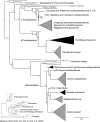Evolutionary relationships among primary endosymbionts of the mealybug subfamily phenacoccinae (hemiptera: Coccoidea: Pseudococcidae)
- PMID: 20851962
- PMCID: PMC2976180
- DOI: 10.1128/AEM.01354-10
Evolutionary relationships among primary endosymbionts of the mealybug subfamily phenacoccinae (hemiptera: Coccoidea: Pseudococcidae)
Abstract
Mealybugs (Coccoidea: Pseudococcidae) are sap-sucking plant parasites that harbor bacterial endosymbionts within specialized organs. Previous studies have identified two subfamilies, Pseudococcinae and Phenacoccinae, within mealybugs and determined the primary endosymbionts (P-endosymbionts) of the Pseudococcinae to be Betaproteobacteria ("Candidatus Tremblaya princeps") containing Gammaproteobacteria secondary symbionts. Here, the P-endosymbionts of phenacoccine mealybugs are characterized based on 16S rRNA from the bacteria of 20 species of phenacoccine mealybugs and four outgroup Puto species (Coccoidea: Putoidae) and aligned to more than 100 published 16S rRNA sequences from symbiotic and free-living bacteria. Phylogenetic analyses recovered three separate lineages of bacteria from the Phenacoccinae, and these are considered to be the P-endosymbionts of their respective mealybug hosts, with those from (i) the mealybug genus Rastrococcus belonging to the Bacteroidetes, (ii) the subterranean mealybugs, tribe Rhizoecini, also within Bacteroidetes, in a clade sister to cockroach endosymbionts (Blattabacterium), and (iii) the remaining Phenacoccinae within the Betaproteobacteria, forming a well-supported sister group to "Candidatus Tremblaya princeps." Names are proposed for two strongly supported lineages: "Candidatus Brownia rhizoecola" for P-endosymbionts of Rhizoecini and "Candidatus Tremblaya phenacola" for P-endosymbionts of Phenacoccinae excluding Rastrococcus and Rhizoecini. Rates of nucleotide substitution among lineages of Tremblaya were inferred to be significantly faster than those of free-living Betaproteobacteria. Analyses also recovered a clade of Gammaproteobacteria, sister to the P-endosymbiont lineage of aphids ("Candidatus Buchnera aphidicola"), containing the endosymbionts of Putoidae, the secondary endosymbionts of pseudococcine mealybugs, and the endosymbionts of several other insect groups.
Figures

References
-
- Akman, L., A. Yamashita, H. Watanabe, K. Oshima, T. Shiba, M. Hattori, and S. Aksoy. 2002. Genome sequence of the endocellular obligate symbiont of tsetse flies, Wigglesworthia glossinidia. Nat. Genet. 32:402-407. - PubMed
-
- Aksoy, S. 1995. Wigglesworthia gen. nov. and Wigglesworthia glossinidia sp. nov., taxa consisting of the mycetocyte-associated, primary endosymbionts of tsetse flies. Int. J. Syst. Bacteriol. 45:848-851. - PubMed
-
- Aksoy, S. 2000. Tsetse—a haven for microorganisms. Parasitol. Today 16:114-118. - PubMed
-
- Baumann, P. 2005. Biology of bacteriocyte-associated endosymbionts of plant sap-sucking insects. Annu. Rev. Microbiol. 59:155-189. - PubMed
-
- Baumann, L., and P. Baumann. 2005. Cospeciation between the primary endosymbionts of mealybugs and their hosts. Curr. Microbiol. 50:84-87. - PubMed
Publication types
MeSH terms
Substances
Associated data
- Actions
- Actions
- Actions
- Actions
- Actions
- Actions
- Actions
- Actions
- Actions
- Actions
- Actions
- Actions
- Actions
- Actions
- Actions
- Actions
- Actions
- Actions
- Actions
- Actions
- Actions
- Actions
- Actions
- Actions
- Actions
- Actions
- Actions
LinkOut - more resources
Full Text Sources
Molecular Biology Databases
Miscellaneous

